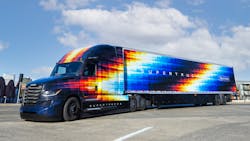“Diesel will remain the predominant propulsion choice for the foreseeable future—because it suits 100% of all applications,” asserted John O’Leary, DTNA president and CEO, to media in Las Vegas at the end of January. “It remains the most cost-effective and efficient way to move goods and people. And we’re far from done with it.”
The next day, DTNA revealed its Freightliner SuperTruck II. The SuperTruck program was initiated by the U.S. Department of Energy (DOE) as a 50/50 partnership with OEMs to improve long-haul Class 8 vehicle freight efficiency.
Read more: Freightliner’s SuperTruck II previews diesel’s more efficient future
Freightliner’s version reached 12 mpg during testing. That was due not only to powertrain improvements, but aerodynamic, tire, and energy management ones as well. The powertrain specifically reduces fuel consumption by 5.7% fuel consumption over SuperTruck I. The noncertified prototype Detroit 13-liter engine features two-stage turbo and interstage cooling and a 13-speed overdrive transmission, and the powertrain can achieve lower downspeeding and more significant fuel savings through reduced drag overdrive.
SuperTruck II’s powertrain also features split cooling. The system consists of high-temperature and low-temperature cooling circuits, working with two-stage turbocharging and Exhaust Gas Recirculation (EGR) cooling on the engine. Together, these technologies create more efficiency gains, enabling more aggressive downspeeding.
A smart engine lubrication circuit minimizes internal pumping losses, thus reducing engine parasitics by actively proportioning flow to the most sensitive components.
Innovations from this demonstrator truck will eventually end up on future production models, just as the first SuperTruck paved the way for modern Freightliner Cascadias.
Navistar, Volvo and Paccar (Kenworth and Peterbilt) are also developing prototypes.
Peterbilt unveiled its SuperTruck II, developed in conjunction with Cummins and other industry partners, last fall. The 15L Cummins engine also employs a 48-v mild hybrid system to power auxiliary systems. dual loop The exhaust gas recirculation (EGR) system has been made dual loop, and Waste Heat Recovery system converts waste heat into useful power, which improves efficiency and reduces CO2 emissions. Cummins reported that due to the recovery system and other improvements the SuperTruck II enigne achieved 55% brake thermal efficiency (BTE).
About the Author
Josh Fisher
Technology Editor
Editor-in-Chief Josh Fisher has been with FleetOwner since 2017. He covers everything from modern fleet management to operational efficiency, artificial intelligence, autonomous trucking, alternative fuels and powertrains, regulations, and emerging transportation technology. Based in Maryland, he writes the Lane Shift Ahead column about the changing North American transportation landscape.
